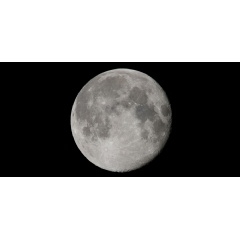What is a supermoon?
When a full Moon occurs at the closest point to Earth during its orbit, it appears larger and brighter, becoming what is commonly known as a ’supermoon’.
A supermoon is widely recorded as being much larger and far brighter than the Moon on any other night - and there’s an easy explanation for it.
Museum planetary science researcher Prof Sara Russell shares what a supermoon is and what makes it shine so brightly.
The supermoon cycleSupermoons are not unusual. They occur as a regular part of the Moon’s orbit of Earth.
Sara explains, ’There is no formal scientific definition of a supermoon, but it occurs when there is a full Moon and the Moon is also closest to the Earth.’
’It is very rare that an orbiting body follows an exactly circular path. The moon has a slight “eccentricity”, meaning it travels in an elliptical path around the Earth - so it is sometimes nearer and sometimes further away.’
Throughout its orbit, the Moon varies between 360,000 and 400,000 kilometres away from our planet.
Perigee is the point at which the Moon is closest to the Earth. When the Moon is at this point, it appears around 14% bigger than a full Moon at the furthest point away, at apogee - when the Moon is sometimes called a ’micromoon’.
’It’s not that much, actually, and it’s doubtful that it makes a huge difference to how it looks, but it gets people looking up at the Moon and thinking about it,’ says Sara.
’The Moon is actually, very slowly, moving away from the Earth, so our supermoon today was just a typical Moon a billion years ago.’
But as a supermoon rises and sets on the horizon, it will appear even larger. This is because of the well-known ’Moon illusion’.
’The Moon, of course, does not vary in size according to where it appears in the sky.
’It may be that when it is near the horizon there are objects, like trees and buildings, that it can be compared in size to, whereas in the middle of the sky there are no points of comparison, which makes it seem smaller.’
A super blue blood MoonOn the night of 31 January 2018, however, the supermoon event promises to be particularly special.
’Not only will this be a supermoon, but it will also be a “blue Moon”, the name given to the second full Moon in a calendar month.
’The Moon is at a stage where it is closest to Earth, and this will last for three full Moons, so that’s why there are three supermoons in fairly close succession. Over the summer, the Moon will go into the further away part of its orbit, and only come closer to us again in early 2019.’
Supermoons cast about 30% more light on the planet than when the Moon is at its dimmest. This is because as it is closer, more of the Sun’s rays that reflect off the lunar surface make it to Earth.
But it gets even more special: on this already rare occasion, the ’blue Moon’ will actually look red, as a lunar eclipse is set to occur on the same night.
’During a lunar eclipse, the Sun, Earth and Moon are in perfect alignment. The Earth is in the middle and blocks out most of the sunlight, but a little light will reach the Moon from around the edges of the Earth.
’As this light passes through Earth’s atmosphere it will tend to refract, or bend, slightly. Blue light bends more than red light, so the blue light is more scattered. More red light tends to make it to the Moon, and is then reflected off the lunar surface to come to Earth. So to us, the Moon appears red.
’Lunar eclipses can look amazing, and when it is a supermoon it should be quite a spectacle.’
Do supermoons cause natural disasters?The ocean’s tides are caused by the gravitational forces of both the Sun and the Moon. Some theories suggest that supermoons can cause some dramatic natural events, such as massive earthquakes and volcanic eruptions.
Sara disagrees: ’There seems to be no basis for thinking this is the case. Natural disasters are no more common when there is a supermoon than when there is not.
’There will be an effect on tides, but this is very tiny, perhaps only affecting them by a few centimetres at the most.’
The supermoon on the night of 31 January 2018 will be our last chance to witness one this year - the next will not be until the beginning of 2019.
( Press Release Image: https://photos.webwire.com/prmedia/7/219612/219612-1.jpg )
WebWireID219612
This news content was configured by WebWire editorial staff. Linking is permitted.
News Release Distribution and Press Release Distribution Services Provided by WebWire.
